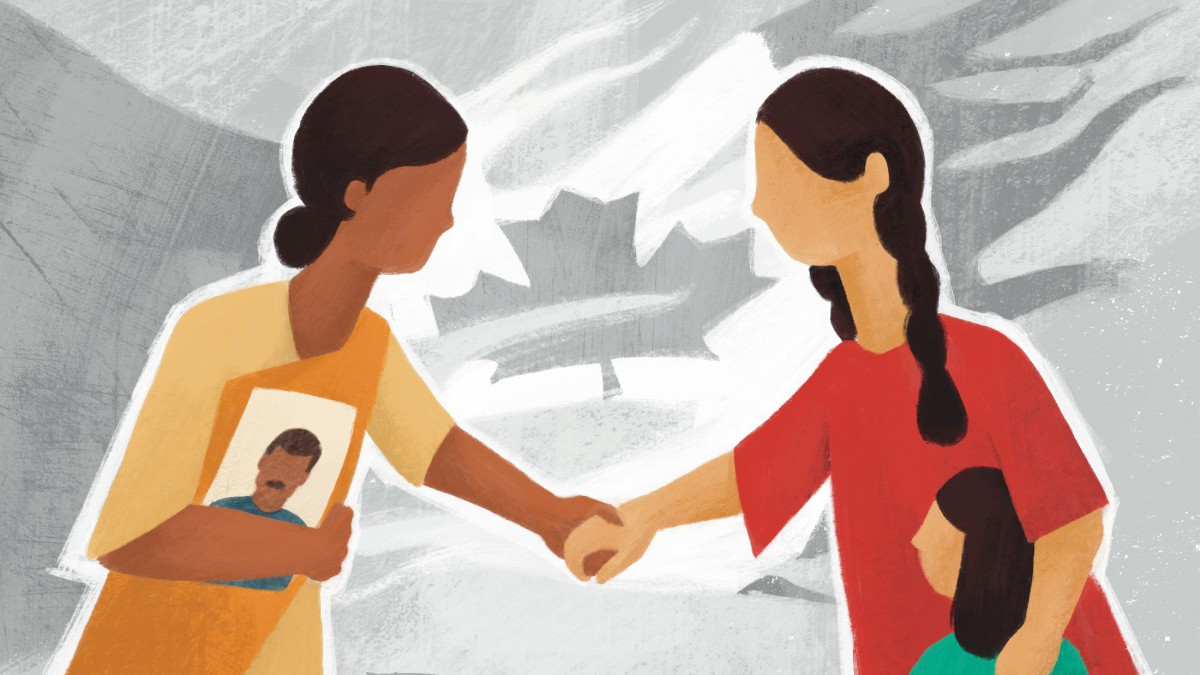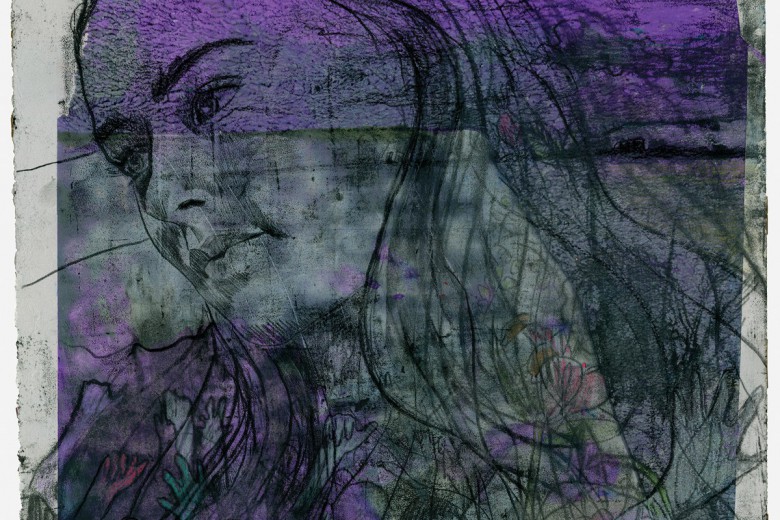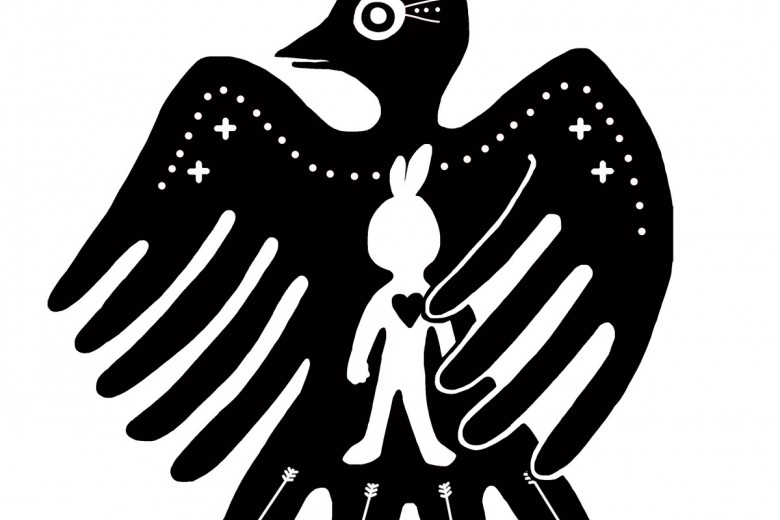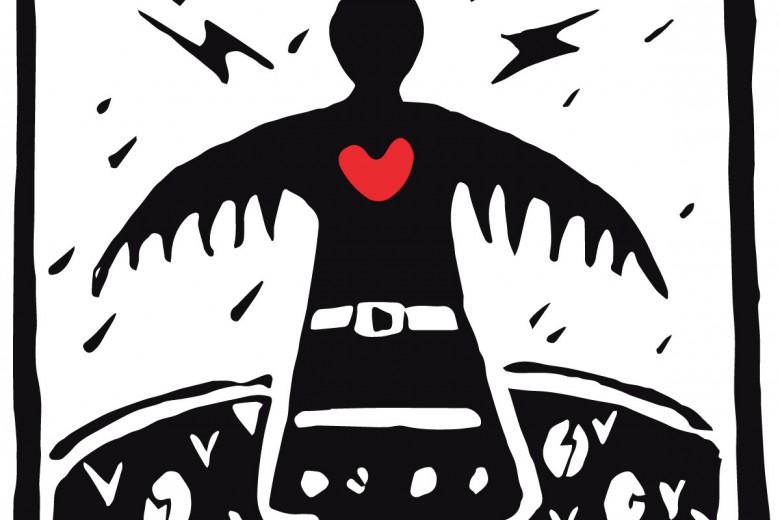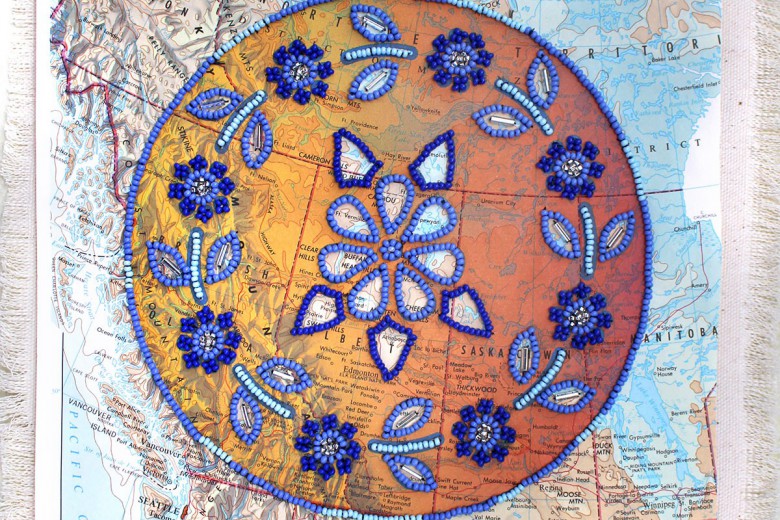We arrive in Mullivaikkal as the sun peaks. My bare feet sink into hot sand that is peppered with the remnants of the livelihoods of the people whose blood soaked this Earth. Here, I find ghosts: the chatter of people who look like me, the outlines of bodies crouched under blue tarp shelters, and the smell of rice and water. The air here is soaked in anguish and grief; it is drenched in longing. Here, I find anger. I am reminded of the room of shaved hair in Auschwitz and the skulls of Tuol Sleng. I am reminded that this is all we have left, that this is all we have to show for what we have lost: shredded pieces of saree, empty medicine bottles, and bits of shrapnel buried under years of sand and oppression.
Following my weeks visiting in the North-East of Sri Lanka, I arrived in so-called Vancouver to start school at the University of British Columbia. It is from here that I write this article, from the unceded lands of the xʷməθkʷəy̓əm (Musqueam) people. From my window, if I look closely, I can see the water that carried the MV Sun Sea in 2010. During my time in Vancouver, I have walked the land where its 492 Tamil refugee passengers were sent after docking in Victoria, and I have driven roads that separated parents and their children as they were whisked into jails across the Lower Mainland. In the months that followed, headlines screamed of “terrorists” and “human smugglers,” reminding the public that Canada’s borders are drawn not only by geography, but by race, fear, and empire.
The decades-long armed conflict in Sri Lanka was fought between the Sri Lankan state and the Liberation Tigers of Tamil Eelam, who fought for an independent homeland in the island’s north and east. Born from systemic state violence, Sinhala-Buddhist nationalism, and decades of disenfranchisement, the conflict formally began in 1983 and ended in 2009 with a brutal military offensive in Mullivaikkal that killed tens of thousands of Tamil civilians.
In the years after the end of the conflict, diasporic remembrance in Canada was treated with a vitriol similar to that spewn on newly-arrived refugees. Memorialization happened within the community, quietly but en masse and with fear of it being labelled terrorism. In the North-East, memory became the front line of resistance as authorities broke out in displays of intimidation and harassment. In 2011, 50,000 Sri Lankan military personnel were deployed in Jaffna alone, patrolling with increased vigilance to quash any attempt at remembrance. In 2012, at least 20 undergraduate students at the University of Jaffna were injured and beaten by riot police during their silent protest on restrictions to memorialization.
This repression continues. In 2016, People for Equality and Relief in Lanka (PEARL) released their report titled Erasing the Past: Repression of Memorialization in North-East Sri Lanka, documenting that efforts “by victims and survivors to commemorate the past are hindered by triumphalist ‘victory’ monuments established by the government throughout the North-East, and are compounded by oppressive state surveillance and restrictions on free speech, free expression and freedom of assembly.” In 2024, the United Nations Office of the High Commissioner for Human Rights (OHCHR) reported that at least 12 out of the 46 cases of the draconian Prevention of Terrorism Act were used to arbitrarily detain “primarily those participating or involved in organization of memorialization activities.”
The work of locating children lost to the violence of the state is now left to the very communities that were once targeted by it.
This treatment is in stark contrast to our current reality in Canada, where more displaced Eelam Tamils have found a home than anywhere else – where we are part of its working class, its elite, and everything in between. We have found power and resistance in this community, in our numbers. Now, politicians across Ontario raise the Tamil Eelam flag in remembrance and solidarity with their constituents; they sit front row at community memorialization events to pay their respects to our fallen, and attest to the community’s incredible resilience in the face of unspeakable violence.
In 2021, a memorial for Tamil martyrs at the University of Jaffna was demolished, an annihilation of the memories and histories of the Tamil people as a result of being branded a threat to Sri Lankan national unity. In response to this erasure and following widespread grassroots condemnation, Brampton city council unanimously voted to build their own memorial to commemorate the Tamil lives lost in the conflict. In August 2024, Sinhalese protesters shouted while the foundation stone to the Tamil Genocide monument was laid on the traditional territory of the Mississaugas of the Credit, Haudenosaunee, and Wendat Nations. In a tweet republished by CBC, Patrick Brown, Brampton’s mayor, said that “while the Sri Lankan regime attempts to whitewash their own blood stained history, we will do the opposite in Canada. We will not forget the Tamil Genocide.”
The Tamil Genocide Monument, which honours the tens of thousands of Tamil civilians killed by the Sinhalese governement, sits on the traditional territory of the Mississaugas of the Credit, Haudenosaunee, and Wendat Nations. Photo by Ambihai Akilan.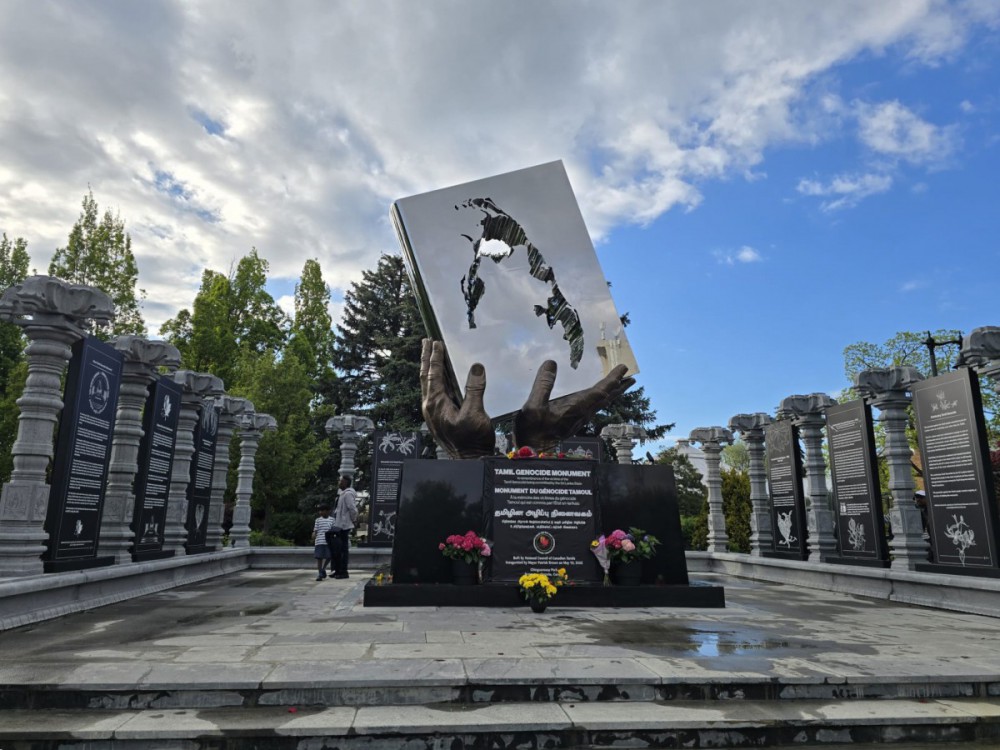
Our drive to Mullivaikkal is punctuated by endless military bases, standing small on their soapboxes of victory and replacing gravestones with checkpoints. Our Tamil does not get us far here – in a land that was once ours, we are now outsiders. We put our cameras down in silent protest as we pass a statue of a grimacing soldier; floating, arms raised, obnoxious in its hypocrisy.
In 2021 – four months after the demolition of the Jaffna University memorial – the potential burial sites of 215 children were found on the grounds of a former residential school in Kamloops. The country called it shocking, but it was simply a confirmation of the violence of residential schools. Then-prime minister Justin Trudeau called it a “painful reminder of that dark and shameful chapter of our country’s history,” a sentiment echoed in a statement by minister of Crown-Indigenous Relations Carolyn Bennett and minister of Indigenous Services Marc Miller. But who is being reminded? And what were they able to forget?
As of 2021, more than 1,300 potential graves have been identified, with many positing that more are still hidden. The grief is heavy, layered, and ongoing. In March 2025, the federal government ended funding to the national advisory committee responsible for supporting these searches. The work of locating children lost to the violence of the state is now left to the very communities that were once targeted by it.
Community memorial consisting of children’s shoes, teddy bears, flowers, and pictures at the Vancouver Art Gallery following the discovery of the potential burial sites of 215 children at Kamloops Residential School. Photo by Frozemint via Wikicommons.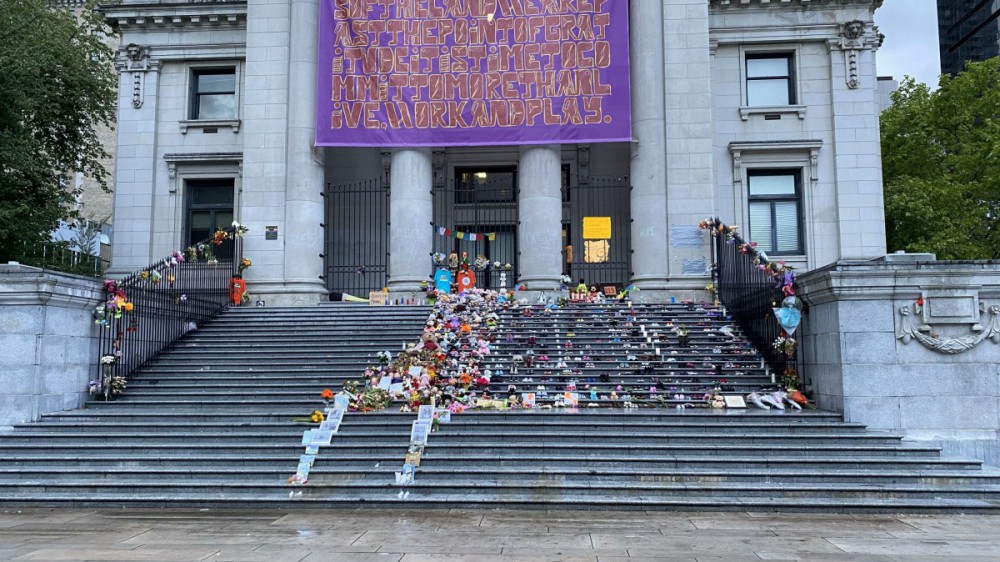
Across the country, while over a hundred Indigenous communities are still trying to find their stolen children, they are simultaneously resisting barriers erected by institutions holding historical records. Communities are also still fighting for access to clean drinking water, confronting the continued impacts of medical racism and forced sterilization, and resisting extractive industries that desecrate their land in the name of profit.
But what does it mean that the Tamil Genocide Memorial now stands on land that was never ours to call home? That it was laid on the soil of the Mississaugas of the Credit, Haudenosaunee, and Wendat Nations, territories still gripped by the violence in Canadian settler colonialism, a violence of which we have become entwined?
In Winnipeg, after three years of unrelenting advocacy, calls were only recently heeded to search the Prairie Green and Brady Road landfills for the remains of Marcedes Myran and Morgan Harris, both from Long Plain First Nation; and Ashlee Shingoose of St. Theresa Point Anishininew Nation (who, until her identification in March 2025, was given the name Mashkode Bizhiki’ikwe, or Buffalo Woman). These women, along with Rebecca Contois of O-Chi-Chak-Ko-Sipi First Nation, were reported missing, their families sounded the alarm, and still, their disappearances went unnoticed until it was too late. It wasn’t until a man searching for scrap metal outside a Winnipeg apartment stumbled upon partial remains that the state began to pay attention. Even then, the Manitoba government initially refused to fund a search of the landfill, citing cost and contamination concerns, a decision that spoke volumes about whose lives are grievable and whose remains are deemed too inconvenient to recover. Three years following the initial discovery, only Myran, Contois, and Harris have been brought home.
The statistics are staggering, but they only confirm what Indigenous women and girls have long known: that they are disproportionately targeted, and overwhelmingly ignored. Indigenous women and girls face a murder rate six times the national average, with murder being the third leading cause of death on reservations. And these are not just numbers. These are names, these are lives, these are people who deserved to be protected in life and remembered after their deaths.
The violence is not only physical but also political, economic, and environmental. It is the result of deliberate, sustained structures of neglect and violence. It is the outcome of a state that criminalizes poverty, that underfunds Indigenous communities, that fails to provide access to safe housing, health care, and transportation. It is rooted in the legacy of residential schools and the Sixties Scoop, in the surveillance of Indigenous parents by child welfare systems that continue to tear families apart at staggering rates. And it lives in the state’s repeated refusal to act – not because the state doesn’t know, but because it has always known and still chooses silence.
Looking out the window, Appa’s friend recognizes a body of water as Nanthi Kadal. Through the window, for less than a second, I meet a place that up until this point, I have only ever known in stories of heartache and despair, on the shores of which the conflict met its end, where bombs fell synchronously to the tune of mass death, on banks littered with floating bodies and what was left of our people. Appa’s friend reminds us that we are not allowed to visit.
In the past 16 years, the Canadian political narrative around the Tamil struggle has changed immensely, and this is no small feat. It is a combination of years of grassroots resistance to the systematic erasure of collective memory and large strides toward making justice, accountability, and self-determination a reality. It is the result of a community that has banded together in collective defiance. But what does it mean that the Tamil Genocide Memorial now stands on land that was never ours to call home? That it was laid on the soil of the Mississaugas of the Credit, Haudenosaunee, and Wendat Nations, territories still gripped by the violence in Canadian settler colonialism, a violence of which we have become entwined? That our struggle, once deemed threatening to the Canadian state, is now held up as evidence of its tolerance?
There is a quiet danger in this embrace.
In fighting so hard for our histories to be seen, our struggles to be validated, we risk losing sight of the legitimization we offer the settler-colonial project in exchange for our recognition by it. Our resistance is not free of contradiction. As displaced people, we carry the wounds of a genocide, but we also carry the responsibilities that come with living and organizing on stolen land. As we push to preserve our own memory, we must also ask: at what cost? Whose erasure makes room for ours to be commemorated? Why must it be an exchange? Have we taken this space, or have we been given it?
Mourning has always been political.
This weaponization of memorialization is not new. In Sri Lanka, it takes the form of destruction – monuments razed, mourners surveilled, the past rewritten in the image of the “victor.” In Canada, memory is not destroyed but reframed, smoothed over and repackaged as proof of a charitable multiculturalism. It is a grief made legible only when it flatters the image of the nation that hosts it.
Mourning has always been political. As political scientist and anthropologist Mahmood Mamdani reminds us, the modern nation-state cannot exist without drawing lines between who belongs and who doesn’t, between those whose grief is allowed and those whose memory is a threat. Nationalism and colonialism, he argues, are not opposites but twins, “joined at the hip.” From the outset, the nation-state has required violence to define itself: expulsion, erasure, ethnic cleansing. Not as exceptions, but as foundations.
The heat here is wet and thick. Here, the syllables of my name fall off tongues like honey. The words I am used to melt into each other, collapsing into a marked departure from my grandparents’ slow enunciation. Here, the joy is contagious and perforated with sorrow, and I cannot fit my body to contain it. I am used to … not this. I am used to loss, a home coated in unspoken yearning.
Now, two years after my time in the North-East, I am preparing to leave so-called Vancouver, to return home to Tkaronto; where I will once again catch whispers of Tamil in grocery store aisles, where I will see more of myself and my history in the people around me, and where I will settle softly into the embrace of community.
It is here that memory was handed down to me, in community centres, in vigils held under streetlights, and in photographs passed between generations. It lives because survivors insisted it must and built remembrance when it was not granted. What has been carved out here did not come easily; it is the product of tireless organizing, of years spent fighting silence with testimony, grief with resistance. It is sacred, and it is political.
Our grief has been made visible in Canada, but how much of it is because it flatters the state to show itself as tolerant? When our grief is framed as proof of the West’s benevolence, we must ask: what does it mean to derive our legitimacy from the very systems that displaced us?
Recognition, in these contexts, is not neutral. It can soften the sharp edges of resistance, recast it as cultural pride, and place it on a pedestal sanitized of politics. When our monuments are erected by the same governments that ignore the unmarked graves beneath their own soil, we must refuse to let visibility become a substitute for justice.
Remembrance, in the hands of both the powerful and powerless, is a weapon. It can be used to sanctify the empire, to cleanse guilt, and to fold resistance into narratives of diversity and inclusion. But remembrance, in its truest form, demands more than recognition. It demands that we hold grief in all its complexity, not only our own, but also the grief of those whose lands we now occupy. It demands that we reckon with the ways we have been made complicit in the very violence we seek to mourn. Remembrance must not only be about looking back: it requires looking around.


